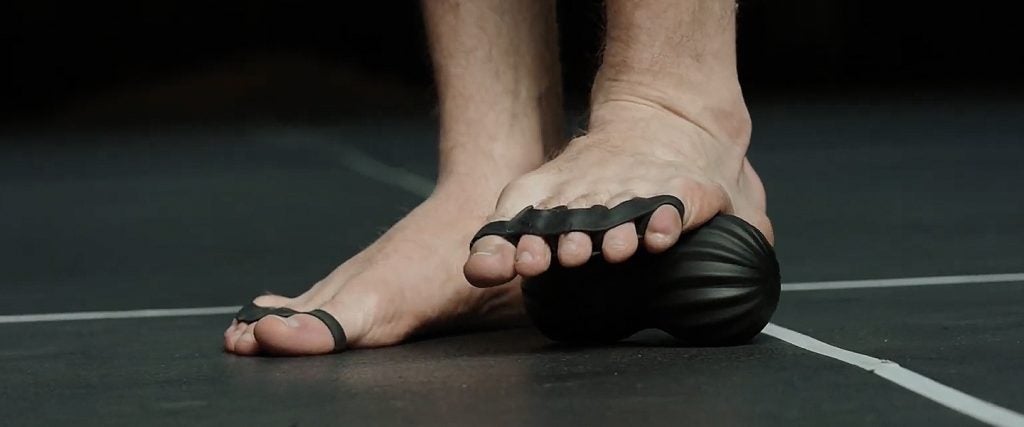I was having an ordinary day in the gym just like any other when I stepped into the fitness studio with the intention of powering through a few push-up sets. The hardwood floor was already occupied by a barefoot woman in navy blue yoga pants, who was executing a series of timed bodyweight exercises while standing on her yoga mat. Among the exercises in her repertoire were slow-motion single-leg squats with one foot elevated in front of her, which appeared to be perilously challenging (and impressive).
It was when her feet were extended that I squinted through my pathetic vision and noticed that her toenails appeared to be adorned by rather conspicuous navy blue nail polish. Only after she walked back and forth across the hardwood floor did I notice that I hadn’t been looking at nail polish — she had something sticking out from between her toes!
Intrigued that she might be in possession of some sort of fitness knowledge that I wasn’t, I waved to get her attention and then asked as unobtrusively as possible, “Do you mind if I ask what you have between your toes?”
“These are my toe spacers,” she responded politely. “They’re supposed to be good for strength and balance. Strength starts from the ground up, so if my toes are strong, then the rest of me should get stronger as well. I learned it from yoga.”
I really appreciated her indulging me, but I couldn’t help but instinctively believe that she had to somehow be incorrect. After all, given all of the time, energy and resources that the R&D departments of the top footwear manufacturers have poured into optimizing the support provided by their shoes, it’s unfathomable to think that any support issues I might unconsciously suffer from could be solved by a temporary insertion of silicone between my toes. But of course, I’m eminently correctable.
Toe spacers? Never heard of them.
Neither had I, but I’ve also never participated in a structured yoga class. To the best of my recollection, toe spacers were packaged in pedicure kits to provide the toes with separation prior to the application of nail polish. For fitness purposes, toe spacers have an advertised purpose of restoring foot mobility and repairing the damage caused by the artificial-narrowing effect of shoes.
My shoes are hurting my feet?
Theoretically, they could be. It’s really all a matter of whether or not they fit you correctly. An ideal pair of shoes won’t force your toes into an uncomfortably narrowed position. They will also provide you with arch support and cushioning for impact absorption.
In other words, the ideal pair of shoes should be the proper size for your feet, and while some shoe designs are deliberately narrow, others that seem too restrictive at first might be perfectly spacious if you purchase them half a size larger.
Okay, but will the toe spacer specifically help me?
According to the research available thus far, the answer is, “Maybe, but probably not.”
Let’s take a look at the groups of people that the studies on toe spacers have specifically addressed. The first study from 2008 demonstrated how three months of wearing toe spacers could provide nighttime pain relief to women suffering from hallux valgus — i.e., bunions. A second study, published in 2012 and conducted with Korean men, found that men who suffered from walking problems experienced improved engagement of all of the muscles responsible for walking processes when they wore toe spacers. However, these benefits were specifically granted to individuals who already suffered from walking problems, not healthy persons.
The final study conducted in 2018 evaluated women suffering from bunions again and identified how they experienced greater improvements in foot strength and functionality when they were asked to exercise while wearing toe spacers for three months, compared with women who received no such therapeutic interventions.
What does this tell us?
This informs us of two things: 1) You should avoid having your toes artificially mashed together by your footwear; and 2) the combination of toe spacers and exercise might be able to help you after the fact if your narrowed toes cause you to experience pain and walking problems. But it’s absolutely not suggesting that you’d magically be able to squat more weight than ever because you performed the lift barefoot with a set of toe spacers on your feet instead of a pair of Adidas Dropsets.
And even if they somehow managed to enhance your lifting in such a fashion, you shouldn’t ignore the other major benefit of shoes aside from the provided stability — the protection they offer. Adding five pounds to your standing military press won’t be worth it if you later accidentally drop that same weight across your exposed toes.

